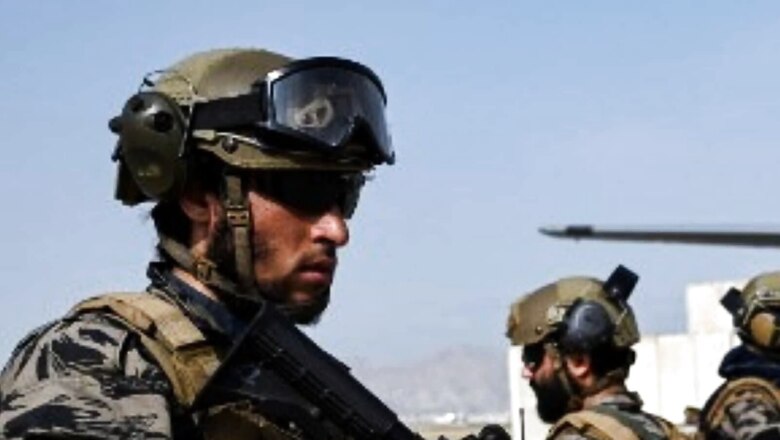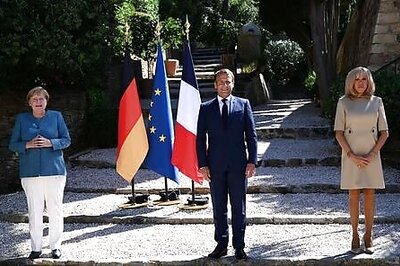
views
The giant doors of the Kherka-ye Sharif shrine, secured by three padlocks clinging together like petals, were flung open. Then, inside the chamber they guarded, were three boxes nestled within each other — the smallest made from the purest silver. Inside was Afghanistan’s most treasured religious relic, the rough camel-wool shawl, which prophet Muhammad is believed to have worn as he flew on the winged horse Buraq to the al-Aqsa mosque, and then ascended to the heavens.
As a huge crowd assembled before Kandahar’s main mosque, the one-eyed cleric, who led the jihadists sweeping across Afghanistan, held up the cloak from its balcony: some present fought to touch the relic; others, it is claimed, fell unconscious in the throes of religious ecstasy.
The founder of the Islamic Emirate, Mullah Muhammad Umar, was then proclaimed Emir-ul-Mumineen, commander of the faithful; leader of not just the Taliban, but all believers.
Few second iterations of history have been as anticlimactic as the rebirth of Afghanistan’s Islamic Emirate on Tuesday, 25 years after Umar’s appearance with the prophet’s cloak in Kandahar. The Taliban’s celebration of their victory consisted of a few shots fired in the air, and a less-than-gripping television address by their spokesperson, Zabihullah Mujahid.
In his moment of triumph, Maulvi Haibatullah Akhundzada, the Taliban’s Emir, was nowhere to be seen. He was, the Taliban said, meeting with other leaders in Kandahar, but the only documentation of this event has been a years-old photograph circulated on social media.
The story of missing Emir, many experts believe, points to a fierce power struggle that has broken out since the Taliban seized Kabul on August 14, at the end of a dramatic, weeks-long campaign.
New leadership heavily dominated by figures from Afghanistan’s south
Last month, following a meeting of the council, the Taliban announced it was forming a new interim council to rule the country. The new leadership is heavily dominated by figures from Afghanistan’s south, many of whom served in the Islamic Emirate regime that disintegrated under Western assault after 9/11.
The military vanguard of the Taliban’s triumph, though, was made up of the so-called ‘Eastern Taliban’— the networks of the jihadist warlord Sirajuddin Haqqani, which enjoys decades-old relationship with the the Tehreek-e-Taliban Pakistan, which operates in Pakistan’s north-west, as well as al-Qaeda, and elements of the Islamic State. Among the ‘Eastern Taliban’ leaders are Anas Haqqani, brother of Sirajuddin Haqqani, and his paternal uncle, Khalil-ur-Rehman Haqqani.
Taliban interim defence minister Abdul Qayum Zakir — who hails from a family in Helmand, and spent time both in Guantanamo Bay and Pul-i Charkhi prison before being released in 2008 — served in the First Emirate as deputy army commander, northern front commander and minister of defence.
Interim interior minister Ibrahim Sadr — also ethnic Pashtun, and among the Taliban’s most important battlefield commanders — served as head of Kabul airport and the Taliban’s small airforce.
Gul Agha Ishakzai, born in Kandahar and who was among Mullah Umar’s closest financial advisors, played a key role in mobilising resources through drug-running and organised crime for the Taliban’s revival after 9/11.
Kabul’s new governor, Muhammad Shirin Akhund, and the city’s interim mayor, Hamdullah Nomani, are also from southern Afghanistan — and veterans of the First Emirate.
Tensions date back to 2016
The tensions date back to at least 2016, scholars Yelena Bieberman and Jared Schwartz have recorded, when Haibatullah divided operational control of the Taliban’s forces between the Haqqanis and Mullah Muhammad Yukub, Mullah Umar’s son.
In a report from May 2017, the United Nations sanctions said the divisions were “also of a tribal nature, with the Noorzai tribe reportedly having taken numerous field commander positions in order to strengthen its position within the Taliban movement at the reported expense of the Ishakzai tribe”.
Founded in the early 1970s — with the backing of Pakistan’s Intelligence Service Intelligence Directorate — the warlord Sirajuddin Haqqani’s network helped lay the foundation of the jihadist movement in Afghanistan, and in Pakistan’s north-west.
The network, scholars Don Rassler and Vahid Brown have recorded in an authoritative book, entwined itself with the Arab jihadists who later blossomed into al-Qaeda.
Yet, scholar Thomas Ruttig has noted that the Haqqanis have no great influence in the First Emirate. Their influence centred in the provinces of Patika, Paktia and Khost. The Haqqanis were kept out by the Kandaharis around Mullah Umar. The eastern tribes, moreover, mostly belonged to neither of the two great Pashtun tribal confederations — the Durrani and the Ghilzai.
Following 9/11, though, the Haqqani network became increasingly important—staging ever-more effective attacks targeting the government and western troops, and helping build the Taliban’s financial backbone. Groups like the Lashkar-e-Taiba and Jaish-e-Muhammad, as well as Pakistna-focussed groups like the Tehreek-e-Taliban, sheltered under the Haqqani umbrella.
In 2016, scholar Antonio Guistozzi found that the Haqqanis even gave support to factions of the Islamic State led by Aslam Farooqi — a jihad commander, who is believed to have trained and deployed Indian nationals from Kerala to stage suicide-attacks inside Afghanistan.
Aijaz Ahanger, a Kashmir-born jihadist, who operated under Farooqi, is suspected by some in India’s intelligence community to have been directed to join the Islamic State by the ISI — having earlier served with both the Tehreek-e-Taliban Pakistan and al-Qaeda. Earlier, Karnataka resident Muhammad Shafi Armar is also believed to have served with the Islamic State, under the command of its emir, Hafiz Saeed Khan.
This complex web of linkages to the wider jihadist movement — and a flow of new fighters, nurtured by the Dar-ul-Ulum seminary at Akhora Khattak, near Peshawar, where the Haqqanis studied — helped make it the most feared single military component of the Taliban.
Lacking tribal influence, will the Haqqanis now use violence to demand what they believe to be a just share of power in Kabul? The Haqqanis’ long-standing links with elements of the Islamic State may make that possible.
Inside the ‘Southern Taliban’, Giustozzi has noted, suspicions are rife that the Haqqanis engineered the recent attack on Kabul, signalling their displeasure at the new power dispensation, and their ability to undermine any future arrangements between the leadership in Kabul and the wider world.
‘Eastern Taliban’, he writes, could “threaten to ‘join ISKP’ if their grievances are not addressed, while the southerners responded that ‘the real Taliban are the southern ones’. The Taliban will indeed need some statesmanship to keep the whole show from unravelling”.
To this, there are questions about how the ISI might seek to manipulate these tensions. Although the ISI backed the Taliban’s negotiations with the United States, conducted through the organisation’s leadership with Doha, it knows there’s little to stop its clients from securing their own interests — and abandoning those of its patrons.
From 2010 to 2018, the ISI kept Abdul Gani Bardar — the head of the Taliban’s negotiating team in Doha — imprisoned in Pakistan, fearful he might seek to cut an independent deal with the United States. Now, the ISI could see the threat of the Islamic State as a useful tool to keep the Taliban in line.
The curtain might have fallen on the long war fought after 9/11, but this much is certain: more than a few acts remain before the lights finally dim on this macabre play.
Read all the Latest News, Breaking News and Assembly Elections Live Updates here.



















Comments
0 comment